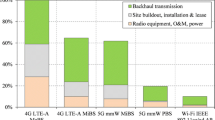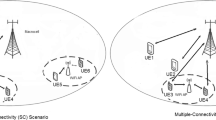Abstract
Multi-service traffic engineering has a strong impact in Mobile Broadband Systems (MBS) revenues, allowing one to obtain merit functions for optimisation purposes, a key aspect in cellular planning. A net cost model is presented for the design trade-offs between re-use pattern, K, coverage distance, R, and spectral efficiency, S ef(R). It allows for the determination of the revenue per basic channel, R 384, that achieves a given value for the annual profit per kilometre. Fast terminal mobility has an important impact in handover failure probability, hence, in system capacity. While in the business city centre and other urban scenarios mobility has no significant effect, it strongly affects the supported traffic in main roads. Comparing the urban with the roads scenarios, a reduction up to 54% may come as a consequence, from (S ef)TOT=32.2 to 15.2%, for R=100 m and K=2; R 384 has to be 0.005 and 0.045 €/min, respectively, i.e., the prices in the roads scenario have to be around one order of magnitude higher than in the urban one. As time goes by, and the use of MBS evolves, the operator will be able to choose different cell coverage distances, in order to support a different number of users, whilst maximising profit. In a medium term scenario, while the number of foreseen users is less than 70% of the number of users in the mature phase, cells with R=200 m will be used.
Similar content being viewed by others
References
G. Anastasi, L. Lenzini, E. Mingozzi, A. Hettich and A. Krämling, MAC protocols for wideband wireless local access: Evolution towards wireless ATM, IEEE Personal Communications Magazine 5(5) (1998) 53–64.
G.A. Awater and H.A. van de Vlag, Exact computation of time and call blocking probabilities in large, multi-traffic, multi-resource loss systems, Performance Evaluation 25(1) (1996) 41–58.
J.M. Brázio and F.J. Velez, Design of cell size and frequency reuse for a millimetrewave highway coverage cellular communications system, in: Proc. of PIMRC'96 – 7th IEEE International Symposium on Personal Indoor, and Mobile Radio Communications, Taipei, Taiwan (October 1996).
L. Fernandes, Developing a system concept and technologies for mobile broadband communications, IEEE Personal Communications Magazine 2(1) (1995) 54–59.
J. Fernandes and J. Garcia, Cellular coverage for efficient transmission performance in MBS, in: Proc. of VTC'2000 Fall– IEEE Semi-Annual Vehicular Technology Conference, Boston, MA (September 2000).
B. Gavish and S. Sridhar, Economic aspects of configuring cellular networks, Wireless Networks 1(1) (1995) 115–128.
B. Gavish and S. Sridhar, The impact of mobility on cellular network configuration, Wireless Networks 7(2) (2001) 173–185.
B. Jabbari, Teletraffic aspects of evolving and next-generation wireless communication networks, IEEE Personal Communications Magazine 3(6) (1996) 4–9.
A. Krämling, M. Scheibenbogen and T. Lohmar, Dynamic channel allocation in wireless ATM networks, in: Proc. of ICT'98– International Conference on Telecommunications, Porto Carras, Greece (June 1998).
S. Littlechild, Elements of Telecommunications Economics (Peregrinus, Stevenage, UK, 1979).
M. Prögler and S. Svaet (eds.), MBS Performance Evaluation, ACTSSAMBA Deliverable A0204/TN/PK/DS/ P/014/b1 (ACTS Central Office, Brussels, 1999).
D. Reed, The cost structure of personal communication services, IEEE Communications Magazine 31(4) (1993) 102–108.
H. Saito, Teletraffic Technologies in ATM Networks (Artech House, Boston, MA, 1994).
J. Sarneki, C. Vinodrai, A. Javed, P. O'Kelly and K. Dick, Microcell design principles, IEEE Communications Magazine 31(4) (1993) 76–82.
F.J. Velez, Aspects of cellular planning in mobile broadband systems, Ph.D. Thesis, Instituto Superior Técnico, Technical University of Lisbon, Lisbon, Portugal (December 2000).
F.J. Velez and L.M. Correia, Capacity trade-offs in mobile broadband systems using guard channels for high mobility handover, in: Proc. of PIMRC'98– 9th IEEE International Symposium on Personal Indoor, and Mobile Communications, Boston, MA (September 1998).
F.J. Velez and L.M. Correia, Classification and characterisation of mobile broadband services, in: Proc. of VTC'2000 Fall– IEEE Semi-Annual Vehicular Technology Conference, Boston, MA (September 2000).
F.J. Velez and L.M. Correia, Deployment scenarios for mobile broadband communications, in: Proc. of PIMRC'2000– 11th IEEE International Symposium on Personal, Indoor and Mobile Radio Communications, London, UK (September 2000).
F.J. Velez and L.M. Correia, Capacity analysis in a multi-service mobile broadband system, in: Proc. of EPMCC'2001– 4th European Personal and Mobile Communications Conference, Vienna, Austria (February 2001).
F.J. Velez and L.M. Correia, Impact of mobility in mobile broadband systems multi-service traffic, in: Proc. of PIMRC'2001– 12th IEEE International Symposium on Personal, Indoor and Mobile Radio Communications, San Diego, CA (October 2001).
F.J. Velez, L.M. Correia and J.M. Brázio, Frequency reuse and system capacity in mobile broadband systems: comparison between the 40 and 60 GHz bands, Wireless Personal Communications 19(1) (2001) 1–24.
Rights and permissions
About this article
Cite this article
Velez, F.J., Correia, L.M. Optimisation of Mobile Broadband Multi-Service Systems Based in Economics Aspects. Wireless Networks 9, 525–533 (2003). https://doi.org/10.1023/A:1024696318236
Issue Date:
DOI: https://doi.org/10.1023/A:1024696318236




